- back
| home | abstract
| contents | next
chapter
Modeling Unconstrained Vector Quantization Complexity
- In the precedent chapter has been presented four different methods
for vector quantization: the exhaustive search and the partial distance
search algorithm as full search methods and the triangular inequality and
vector-to-scalar mapping elimination as fast search methods. Further we
have estimated for each algorithm a theoretical computational complexity,
the number of operations, necessary to encode a vector. For the exhaustive
search this complexity is independent of the codevectors. Where for the
partial distance search method this distribution directly influence its
efficiency. The fast search methods on the other hand exploit this distribution
to make an estimation for the codevector and then to search in its neighborhood.
In the presented formulas we have assumed for this search the exhaustive
search algorithm, but its obviously, that for practical applications the
partial distance search algorithm or an other appropriate algorithm can
be used to further reduce the complexity. Therefor we try to model in the
following chapter the partial search algorithm. This model when can be
adjoined to the theoretically attainable inferior limit for each method
to get an approximation for the computational complexity.
- Two approaches are presented in the following. The first is to use
the experimental results presented by the different authors to get a model;
the second is to implement the partial search algorithm and to estimate
the model ourselves.
3.1 Complexity
Structure of the Partial Search Algorithm
- The partial distance search algorithm is a full search method. This
means, that each of the codevectors in the codebook is affected by the
search. Therefor the encoding of a source vector needs a minimum number
of operations depending of the codebooksize N and its dimension k. This
contribution to the complexity is independent of the distribution of the
codevectors. Each distortion calculation is performed by cumulating the
squared difference between the pixel of the source vector and the codevector.
There this accumulation has maximal k iterations, which is the dimension.
The exit condition for this loop is when the accumulated distortion is
greater than the minimal known distortion. When this is performed depends
of the pixel values and hence of the codebook distribution. So only an
average number of iteration can be considered.
| independent part | dependent part | |
| number of additions S per vector | 2k+2(N-1) | 2(N-1)(kC-1) |
| number of multiplication P per vector | k+N-1 | (N-1)(kC-1) |
| number of comparisons C per vector | k+N-1 | (N-1)(kC-1) |
| total | 4k+4(N-1) | 4(N-1)(kC-1) |
There the average number of iterations is restricted to 1£ kC £ k. When searching for a complexity model the independent part can always be subtracted. As we have seen, is this substantial for large codebooks and small dimensions. So to get a model for partial distance search algorithm it is necessary to know the average number of iterations for different codebooksizes and dimensions
3.2.1 Existing Experimental Results
- The following table resumes the average number of addition, multiplication
and comparison per pixel for different authors. The selection is restricted
to a codebooksize of N = 256 and 512 and a dimension of k = 8 and 16.
| source | N | k | operations per pixel | inferior limit | min | max |
| [25] | 512 | 16 | addition | 65.875 | 58.4 | 144.7 |
| multiplication | 32.9375 | 45.2 | 88.3 | |||
| comparison | 32.9375 | 45.2 | 88.3 | |||
| [13] | 256 | 16 | addition | 33.875 | 71.21 | 97.56 |
| multiplication | 16.9375 | 43.61 | 56.78 | |||
| comparison | 16.9375 | 43.61 | 56.78 | |||
| [18] | 256 | 16 | addition | 33.875 | 222.6 | |
| multiplication | 16.9375 | 111.3 | ||||
| comparison | 16.9375 | 111.3 | ||||
| [12] | 256 | 16 | multiplication | 16.9375 | 57.865 | |
| [26] | 256 | 8 | addition | 65.75 | 106.78 | 154.98 |
| multiplication | 32.875 | 69.39 | 93.49 | |||
| comparison | 32.875 | 69.39 | 93.49 | |||
| [8] | 256 | 8 | multiplication | 32.875 | 50.5 | 145.2 |
| [7] | 256 | 8 | multiplication | 32.875 | 66.00 | 68.3 |
- First to note is that all authors quote Bei and Gray [7]
as the source for their algorithm. If we take a closer look to the above-established
relations for this algorithm, we notice that the number of comparison and
the number of multiplication should be the same and that the number of
addition is the double of these. But the experimental results, except for
Poggi [18], violates all the relation
between the number of addition and the number of multiplication and the
number of comparison. Further Poggi [18],
Lo and Cham [13] and Ngwa-Ndifor and Ellis
[12] are using the same test image, but
Poggi obtains a result, which is about two times greater. This is only
possible if the codebook is ordered for the worst case, like the results
by Paliwal and Ramasubramanian [8] show.
Their minimum value is for an ordered codebook and the maximum value is
for an inverse ordered codebook. Finally Lai and Tai [25]
obtain a minimum value, which is inferior to the theoretical limit. So
there is a fort inconsistency between the maden considerations and the
experimental results. We don't know their particular implementations, a
difference could only result if instead of the Euclidean squared norm an
other norm is used for the distortion computation. Anyway we try to estimate
with these data an average number of iteration. This for having a coarse
idea about its possible dimension.
With the help of the expressions for the number of operations for addition,
multiplication and comparison we can compute the average number of iteration
for each combination codebooksize N and dimension k. There the expected
values should be restricted to 1£ kC£
k.
| source | N | k | average number of iterations based on | min | max |
| [25] | 512 | 16 | addition | 0.883 | 2.234 |
| multiplication | 1.384 | 2.734 | |||
| comparison | 1.384 | 2.734 | |||
| [13] | 256 | 16 | addition | 2.171 | 2.998 |
| multiplication | 2.674 | 3.500 | |||
| comparison | 2.674 | 3.500 | |||
| [18] | 256 | 16 | addition | 6.921 | |
| multiplication | 6.921 | ||||
| comparison | 6.921 | ||||
| [12] | 256 | 16 | multiplication | 3.568 | |
| [26] | 256 | 8 | addition | 1.644 | 2.400 |
| multiplication | 2.146 | 2.902 | |||
| comparison | 2.146 | 2.902 | |||
| [8] | 256 | 8 | multiplication | 1.553 | 4.524 |
| [7] | 256 | 8 | multiplication | 2.039 | 2.111 |
- We find a range for the average number of iterations between 0.883
and 6.921. The inconsistency still remains for the above-discussed reasons.
For the following estimation the values of Poggi [18]
are omitted. They are the only ones, who match with our assumptions, but
they are too large by factor two compared to the over values. Also the
values of Paliwal and Ramasubramanian [8]
are not considered, because they are obtained by ordering the codebook,
which isn't the case for the other values. So the range is reduced from
0.883 to 3.568.
- At a first glance no value is matching for all combinations. There
is no reason to be so, because the average number of iterations is influenced
by the distribution of codevectors in the codebook. Instead to search for
an appropriate distribution, we introduce one more parameter. So we assume
an unknown distribution characterized by two properties. Following the
modified expressions for the number of addition, multiplication and comparison.
| number of additions S per vector | 2(kI+(N-I)l ) |
| number of multiplication P per vector | kI+(N-I) l |
| number of comparisons C per vector | kI+(N-I) l |
| total | 4(kI+(N-I) l ) |
- The parameter I is the average number of codevectors needing the complete
distortion computation, so satisfy the condition d2 £
dmin2. Where l is the
new average number of iterations, which should be inferior to kC.
For l = kC and I = 1 we obtain the
same expressions as used up to now. Therefor this two parameters are not
independent and it can be derived a relation between kC, l
and I for a given codebooksize and dimension. The following Figure
3 represents the relation between the parameters for different N and
k and the corresponding maxima, thick line, and minima, thin line, values
for the average number of iterations listed in the above table.
For the same codebooksize to dimension proportion nearly the same slope for the maxima-minima ribbon exists. Further that this slope increases with the diminution of the proportion. An evident relationship between I, l and N, k can't be recognized, but the values have to lie in the plane such that they are limited by the lines for kC = 1.644, 2.171, 2.734 3.568 and the limit.

- begin chapter
|
next chapter
- To obtain reasonable results we have implemented the algorithm ourselves.
The number of operations has been measured for different codebooksizes
N and dimensions k. In the following we describe the used algorithms and
give an interpretation of the established values.
For every combination codebooksize and dimension a codebook has to be computed. We used for that the LBG-algorithm presented in [6]. With the already described exhaustive search algorithm, a training set of vectors and set of initial vectors a codebook is generated, such that the initial codevectors converge to the codevectors representing a minimal overall distortion for the training set. This is an iterative process, at each repetition each training vector is associated to its nearest neighbor codevector resulting in N subsets called Voronoi regions. When for each subset the centroid is computed. These vectors constitute the new codevectors and the procedure can be repeated once more. To save computation time we made ten iterations and didn't execute the calculations until the minimum distortion has been reached. The measured distortions state, that this number of iterations is sufficient and that the distortion is near enough to the minimum. For the initial codevector we selected vectors of the training set with a distribution along its squared Euclidean norm. The vector quantization is obtained by using the partial distance search algorithm as described in 2.1.2. The number of operations for addition, multiplication and comparison was measured by incrementing each a counter. For further details the corresponding MATLAB files are listed up in the annex B.
As the training set we used the images peppers, baboon, barb, gold and as the source image lena.
The following table resumes the measured average number of multiplication
or comparison operations per pixel. As discussed above, the number of addition
operations are these values multiplied by a factor two and the total number
of operations are these values multiplied by four.
| codebooksize N | |||||
| 64 | 128 | 256 | 512 | ||
| dimension k | 4 | 32.8 | 63.6 | 124.4 | - |
| 8 | 26.7 | 51.9 | 101.0 | 201.0 | |
| 16 | 23.8 | 46.3 | 88.1 | 169.1 | |
| 32 | 25.4 | 46.7 | 85.6 | 166.1 | |
| 64 | 26.1 | 47.3 | 87.8 | 163.9 | |
The experimental results are in the same range as the results by Poggi [18]. This proofs that the other authors are using a different partial distance search algorithm than described by Bei and Gray [7].
Before giving an interpretation, there is to note that only large codebooks with small dimensions are for practical use. So only vector quantization resulting in a small distortion is applied. The following Figure 4 shows the growing degradation. The first picture is the original. The others are obtained by quantizing with a codebook of size N=512 and the dimension k = 8 for the upper right, k = 16 for the bottom left and k = 32 for the bottom right. So with increasing dimension the bit rate is decreasing. This is equal to a loss in information as it can be observed in the following pictures.
The growing degradation states also in the experimental results. With increasing dimension the complexity passes by a minimum. So for the following parameter estimation, only the shaded values in the table are considered.

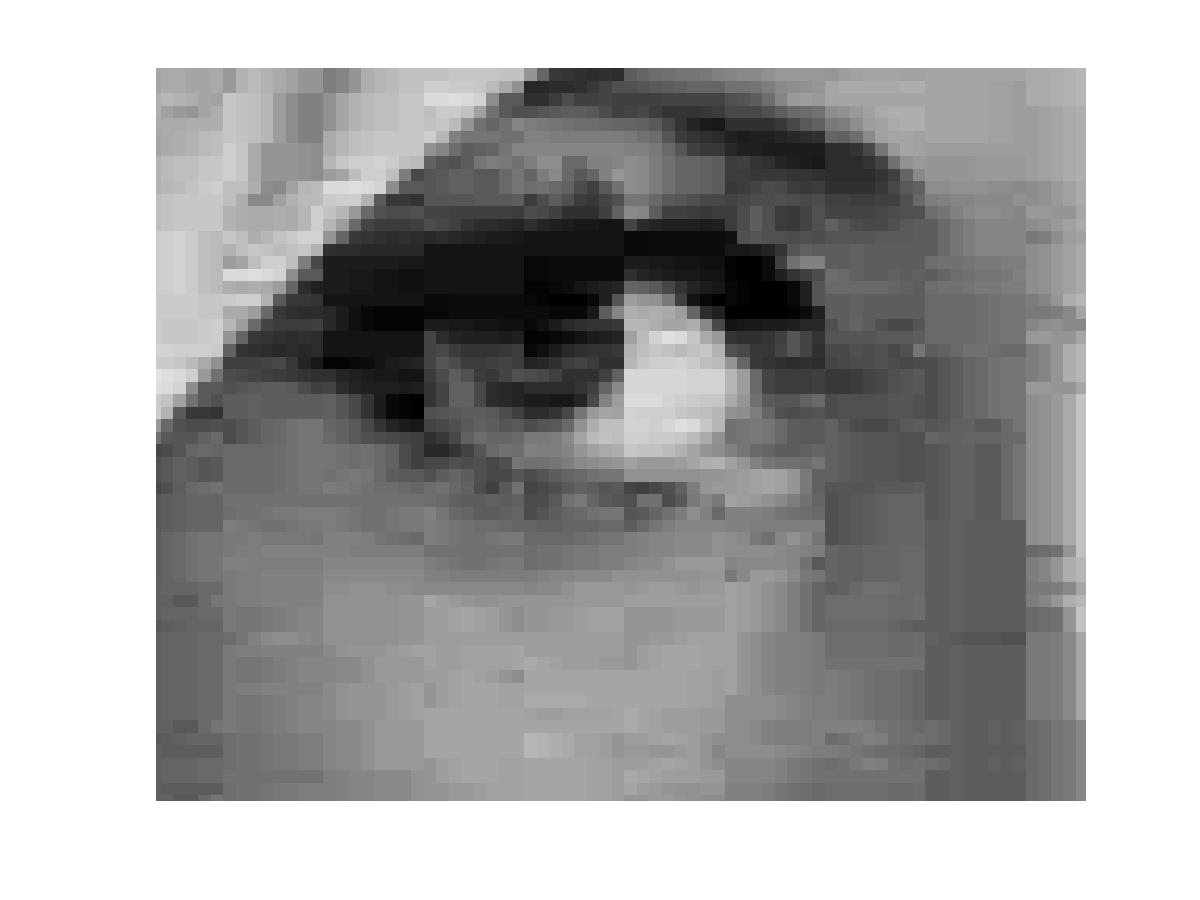
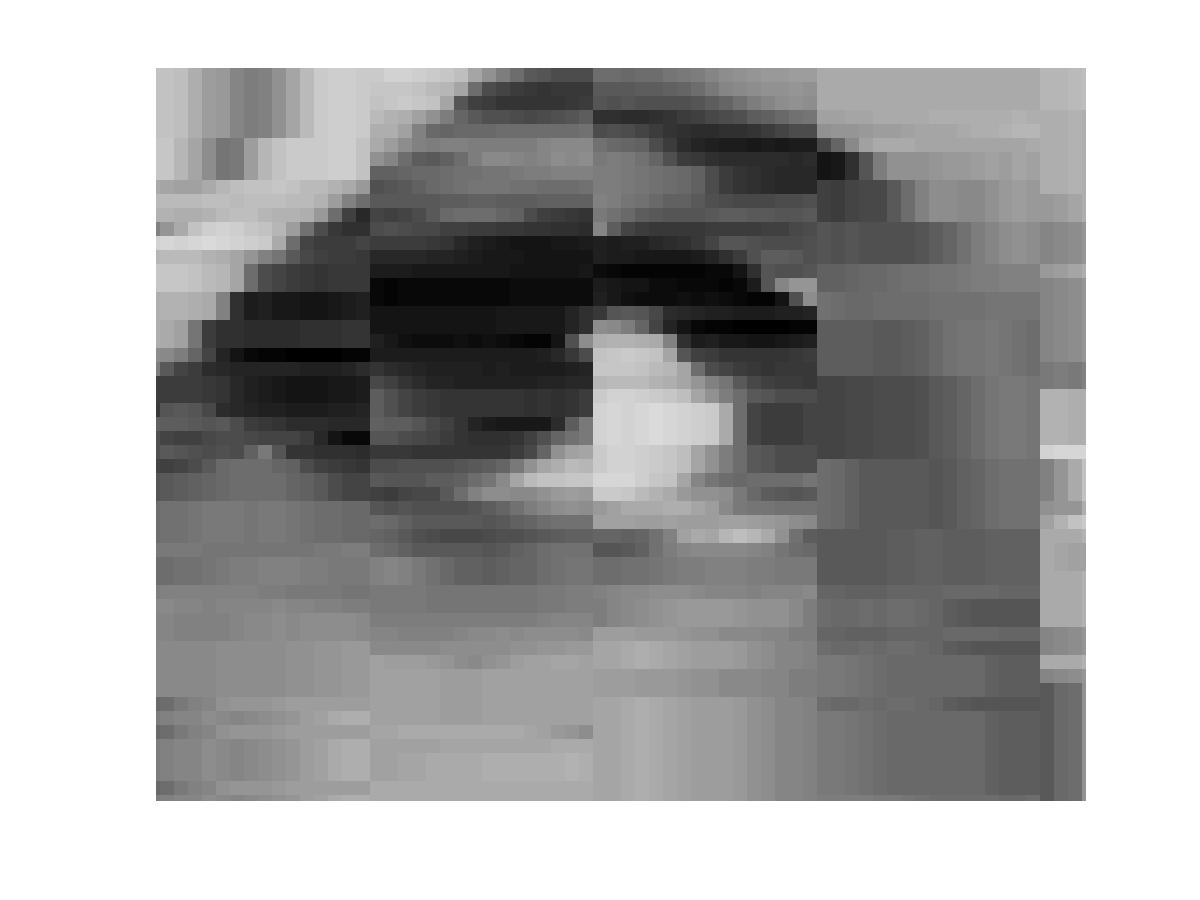
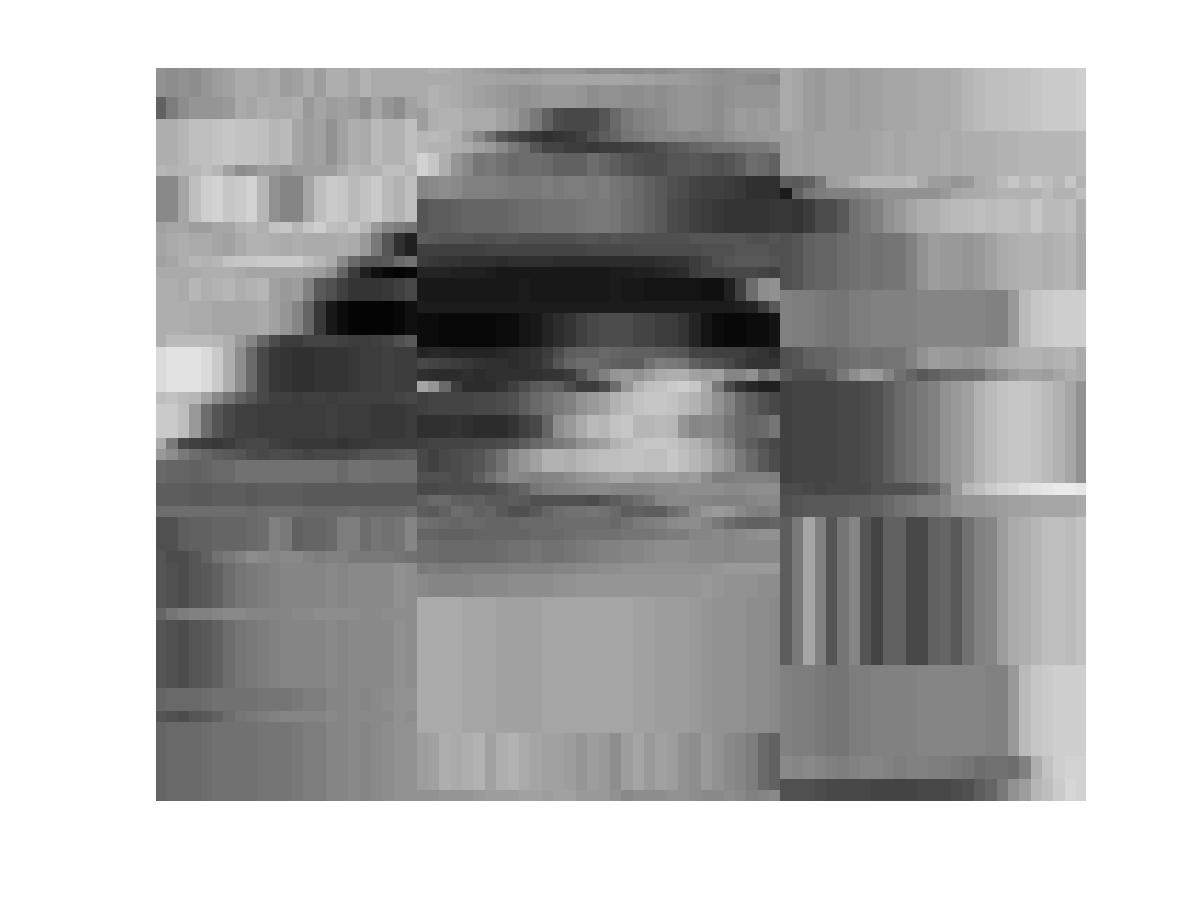
Figure 4: Vector quantization
with the partial distance search algorithm for different codebooks. Upper
left: original picture. Upper right: codebooksize N = 512, dimension k
= 8 Bottom left: codebooksize N = 512, dimension k = 16 Bottom right: codebooksize
N = 512, dimension k = 32
As for the existing experimental results we compute the average number
of iterations kC. Because of the proportionality between the
number of addition operations and the number multiplication and comparison
operations only one value is obtained. The values are listed up in the
following table for the considered codebooksizes and dimensions.
| codebooksize N | |||||
| 64 | 128 | 256 | 512 | ||
| dimension k | 4 | 2.019 | 1.972 | 1.936 | - |
| 8 | 3.264 | 3.206 | 3.137 | 3.131 | |
| 16 | 5.790 | 5.707 | 5.465 | 5.263 | |
| 32 | - | - | 10.616 | 10.339 | |
| 64 | - | - | - | 20.402 | |
- We state, that for a given dimension k the average number of iterations
is nearly constant. For increasing codebooksize the values are slightly
decreasing. Further that with doubling the dimension k the average numbers
of iterations have the tendency to double the values too. If we assume
kC constant for a given dimension k, it still rests to find
a relation between the kC for a given codebooksize. Again we
use the parameters I and l to find an appropriate
description. The following Figure 5 shows these parameters
for the above computed average number of iterations.
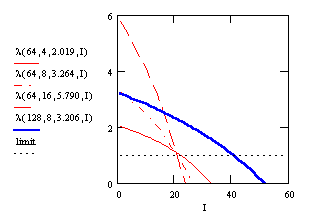



For a given codebooksize the graphs for different dimension cross approximately in one point near the limit. Further we have a similar slope for the same codebooksize to dimension proportion. Due to the doubling of kC for a given codebooksize, the parameter I at the crossing point is also doubling with increasing N. The proportional factor between I and N is about 0.316. So we propose the following parameters to modeling the partial search algorithm.
![]()
- The calculation made in annex A shows, that the proposed value for
I is constant for the different codebooks. With a constant I the parameter
l
can be derived. These values are only approximately constant; they decrease
with increasing codebooksize. Anyway we assume
l
constant in view, that we suppose a model for the partial distortion search
algorithm with only two parameters. Following the final expressions for
the number of addition, multiplication and comparison.
| Number of additions S per vector | 2N(0.316k+0.684) |
| Number of multiplication P per vector | N(0.316k+0.684) |
| Number of comparisons C per vector | N(0.316k+0.684) |
| total | 4N(0.316k+0.684) |
- This relations are valid for codebooksize from N = 64 up to 512 and
dimensions from k = 4 up to 64 with the best matches for the combination
shaded in the above table. The following Figure 6 shows the total number
of operations. The plane is our proposed model, where the bars are the
proper experimental results. The next Figure 7 shows the error. The difference
is maximal for the codebooksize N = 512. The reason is, that we fixed the
average number of iterations, but in fact it is decreasing with increasing
codebooksize.

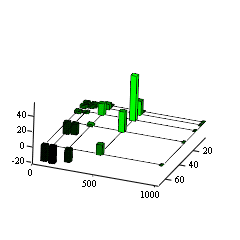
- Finally we found with the above relations a superposition function,
which can be adjoined with the inferior limit functions for the triangular
inequality elimination and the vector to scalar elimination method. The
model is only valid if the size of the expected subsets of codevectors
is in the range from 64 to 512. For practical application the model has
to be extended to smaller codebooksizes.
- We have now also the weighting function to obtain the partial distance
search complexity from the exhaustive search complexity. This function
represents also the gain in complexity by passing from one method to the
other. The following Figure 8 shows this relationship.
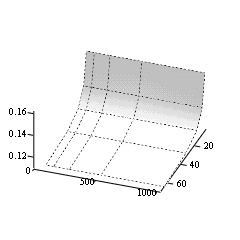
Figure 8: The gain of complexity reduction by passing from the exhaustive search algorithm to the partial search algorithm
- The gain of complexity reduction is by a factor in a range from five
to ten. To note is that the gain is approximately constant for a given
dimension. With increasing dimension the gain is also increasing but the
bit rate is decreasing as we have seen above. So the quality degradation
sets a limit in choosing the codebooksize.